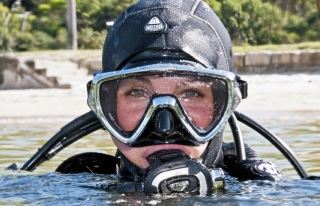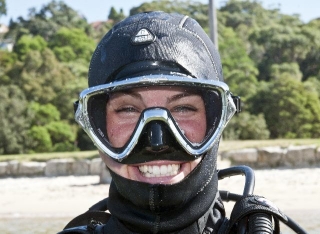After arriving back from the whirlwind tour of New York it was time for an unforgettable trip to the Tabata warehouse to pick up my dive gear. Sue Crowe kindly drove me out to the warehouse where I met all the loverly Tabata staff. Derek, the Tabata warehouse manager, was kind enough to give me an extremely thorough tour of the warehouse, filling me in on everything from how gear is distributed to the importance of distinguishing between silitech and silicone mask skirting. As we walked through the rows and rows of fins, masks, BCD’s and regulators I couldn’t help thinking how lucky I was to be given the opportunity to go behind the scenes in an industry which had been involved with since I was 16.
It was then time for fitting and boy was there a lot to try on!! I firstly chose a mask, then boots and fins, and then BCD and regulator. Wetsuits were next and I tried on a beautifully fitting Waterproof 3 ml, followed by a 7 ml. Before I even put the Waterproof suits on I could tell that they were of the highest quality, and were perfected right down to the last intricate detail. Even the non slip embossing in the back of the suit is braille for waterproof!! Finally it was time for donning my dry suit and by that time I was actually pretty exhausted. For anyone who has not tried on a dry suit (as I had not at the time), it requires quite a deal of skill and persistence – thanks so much for your help and dealing with my general lack of co ordination Sue! My dive gear reception extravaganza was nearing at its end but incredibly there was still more to go including gloves, dive knife, T-shirts, and so much more. I want to sincerely thank everyone at Tabata for there amazing generosity.
Two days later I had only just started to recover from the shock of such an incredible day at the Tabata warehouse and it was time to test out my gear with Jayne Jenkins and Karen Raubenheimer at Sydney’s Chowder Bay.
[cetsEmbedGmap src=http://maps.google.com.au/maps?client=safari&rls=en&oe=UTF-8&redir_esc=&um=1&ie=UTF-8&q=Chowder+Bay&fb=1&gl=au&hq=Chowder+Bay&cid=0,0,9150901002209778473&ei=04vDT46eMuiciAfAuIiyCg&sa=X&oi=local_result&ct=image&resnum=2&ved=0CBQQ_BIwAQ width=420 height=510 marginwidth=0 marginheight=0 frameborder=0 scrolling=no]
This was the first time I had ever dived in temperate conditions and I was super exited to see what it was like. I followed Jayne and Karen into the water and soon we were swimming towards an underwater fence covered with colorful sponges, ascidians and anemones. Further along we swam through heavily encrusted pier pylons full of gobies, blennies, cleaner shrimp, triggerfish, seahorses, frogfish, leatherjackets and pipefishes. I also saw a number of juvenile reef fishes that I was used to seeing in tropics. While these fishes can make it down to Sydney on the EAC (thank you Finding Nemo), unfortunately they do not survive the winter – poor little guys. I loved this dive and funnily enough it was only after I surfaced that I was informed that the visibility was some of the worst that Jayne had ever seen. If Chowder Bay was that good in relatively poor vis I couldn’t help thinking how amazing it must be in clear conditions. I was definitely coming back! Thanks for your wonderful pictures Jayne 🙂
After diving for most of the summer in hire gear at least one size to large for me, I was ecstatic to dive in my new Tusa BCD (BCJ-9300C Selene II) and Regs (RS-680). The BCD fit me perfectly and not only was it incredibly comfortable but it also allowed me a lot of flexibility to move during me dive. I also greatly enjoyed diving with my new M-110SQB-CR Visio Pro mask. I have had a lot of trouble with too much glare penetrating my previous mask and therefore wearing a mask with advanced UV Lens Treatment and Anti-Reflective (A/R) Lens Treatment was a fantastic change, allowing me to fully appreciate all the incredible marine life at Chowder Bay.
On Saturday it was time to leave Sydney behind and I embarked on my mission to visit the Sensory Neurobiology Group, formally the Vision Touch and Hearing Research Centre at the Queensland Brain Institute. Okay so just a little bit of background. When I received the scholarship I just previously completed my Honours project and one of the major components was to investigate the daily temporal activity and foraging patterns of coral reef rockcod and their prey, lemon damselfish. My Honours findings suggested that the predators where active primarily at dawn and dusk.
I had always wanted to see whether these rockcods had a visual sensory system adapted for crepuscular (dawn/dusk) activity. Following my Honours and while working as a research assistant, I was fortunate enough to meet Professor Justin Marshall who showed me how to dissect out the retina of fish. These retinas can then be used to analyze the composition of photoreceptors. Common photoreceptors are cones (used for daytime vision) and rods (used for night time vision). If you have a look at the pictures below you can see the progression of cone dominated eyes (in fish that are predominantly active in the daytime), to rod dominated eyes (in fish that are more active during the night). It was my hypothesis that rockcods would have a retina with intermediate numbers of rod and cone cells, allowing them to function at lower light levels.
With the help of Genevieve Phillips, a PhD student with Justin Marshall, I managed to dissect out six retinas and then it was a question of well what to do with them? As part of my scholarship year I decided to travel to Brisbane to whole mount the retinas and talk to Justin a little more about research opportunities with his laboratory. All in all the whole mounting went really well and in the end we had four retinas to look at under the microscope. Interestingly, preliminary analysis suggested that rockcods could indeed have rod dominated retinas however according to Justin more would be needed before any firm conclusions can be drawn.
During my stay in Brisbane I was also lucky enough to talk to lab manager Alan Goldizen and Dr Martin How. Alan was kind enough to tell me all about the deep water exploration project which will hopefully be up and running later this year. Justin and his team are getting ready to explore the deep water fish and coral communities of the Great Barrier Reef using Deep Rover Submersibles. I also now know a lot more about Stomatopod (mantis shrimp) vision thanks Dr Martin How. Mantis shrimps have compound eyes with more photoreceptor cells than any other animal. In contrast to Humans who have four visual pigments, mantis shrimps have 16!! Mantis shrimps also have the ability to detect polarised light allowing them to communicate in secret away from the watchful eye of predators. For more information see http://web.qbi.uq.edu.au/ecovis/stomatopods.htm
I also met Diana Kleine and Angela Dean from Coral Watch, which is a non-profit research project at the University of Queensland. Coral Watch uses the Coral Health Chart to monitor the health of coral reefs in an inexpensive and non-invasive way. Members of the community simply compare colours of corals with colours on the chart and record matching codes. Each colour represent different stages of bleaching/ recovery, based on controlled experiments. I had a great time talking to Angela about Coral Watch and hope to maybe help out with this at some point in the year. It is a great example of a project which not only helps to document reef health, but also engages the community and builds public awareness. Keep up the great work guys!
Stay tuned for Perth, Ningaloo, and lots of Whale sharks!























